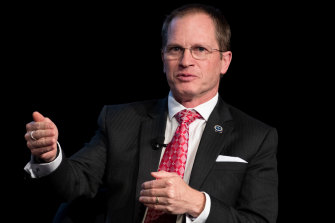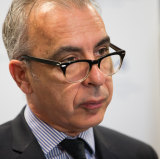By Jordan Baker
School principals have a tough job. They educate hundreds of students, oversee dozens of staff, and manage budgets that never seem to stretch far enough. They deal with irate parents, answer to bureaucratic bosses, struggle to staff classes amid one of the worst shortages in decades and, in some of Sydney’s more disadvantaged areas, help their students through traumas beyond imagination; neglect, abuse, hunger, poverty.
All this means a good principal can transform lives. But a bad one can stifle the potential of countless students and teachers.

Principals are trusted figures in the community.
Many across senior ranks in and around NSW education quietly admit principal quality is patchy. There are excellent principals but not enough of them for every school. Some are ineffective, complacent, or poor managers of people. And little can be done about those; once they are promoted, they have tenure. This quality problem is not confined to NSW, nor to public schools. The Catholic system has a similar challenge.
“There is definitely a quality issue among principals,” says one person with significant knowledge of the sector, speaking on the condition of anonymity so they could speak freely.
Principals are important. Says Tom Alegounarias, the head of the University of Sydney’s Centre for Educational Measurement and Assessment: “The key point for affecting student outcomes is teachers, but what is consistently underestimated is the key to affecting the quality of teachers is principals.”
Principals are also powerful; they have a high profile in their communities, and their job title puts them in a position of trust. Their power is one reason why the quality problem is whispered, not tackled. Another is that, while they are a small proportion of union members, they are the most influential.
Says one education veteran, speaking on the condition of anonymity so they could speak freely: “The key variable for controlling the [public education] debate is which side the principals land on. “When the principals land on the teachers’ side, they’re going to win the discussion. If the principals land with the government, they tend to get what they want. When you add that every principal has access to a community, to voters and not just teachers, then they are an important political variable you don’t want to alienate.”
The problem, like almost every issue confronting schools, has been decades in the making. Before the Greiner government education reforms in the late 1980s and early 1990s, inspectors assessed teachers’ suitability to be put on a list of candidates for promotion.
Says a senior education executive, also speaking on the condition of anonymity: “We got rid of [inspectors] and that was a tragedy, and a lot of us thought so at the time. It was designed to be a coaching opportunity as well as an inspection.”
It was replaced with an interview process, involving an application and a CV, which, particularly in its earliest incarnation, rewarded people who were adept at interviews and the busy work that crowded their CV with achievements, rather than those who got on with being exceptional teachers and leaders. Critics say the process has improved over time but that it still has flaws.
However, NSW Secondary Principals Council head Craig Petersen says it is rigorous. “We write our applications in a really unique way,” he says. “For each one of the criteria, they need one page of narrative text, what are the outcomes, what is the evidence of impact. They have to attest there are no performance issues. They can’t be on an improvement program, or under investigation.”

Craig Petersen, head of the Secondary Principals Council, says it is up to the department to provide professional support for principals.Credit:Janie Barrett
The problem was exacerbated by a policy introduced about a decade ago, called Local Schools, Local Decisions, which gave NSW public school principals far greater autonomy. This was one example of a reform opposed by the NSW Teachers Federation but supported by principals.
As part of the reforms, teams within the NSW Department of Education that helped schools with everything from curriculum to behaviour were axed, and the money was given to principals to spend as they deemed necessary. The idea was that every school was different, and only the principal really understood what was needed.
They selected their own educational programs, hired half their staff on merit (the other half were imposed on them through the transfer system) and identified the “professional development” (on the job training) needed by their staff. Around the same time, billions of extra Gonski money began flowing. Principals suddenly ran much bigger budgets, but were given no extra training in financial management, and no guidance in the most effective ways to use it.
The unspent $1.5 billion
Some spent it. Some benefited from it, by leaving the profession and joining a lucrative professional development industry that grew with barely any quality control (this is being rectified). And some didn’t know what to do with it. As of the beginning of last year, NSW public schools were sitting on almost $1.5 billion in unspent cash. Says the executive: “They’re bureaucratic in their mindset; they didn’t spend it, or they did silly things with it.″
The government now acknowledges Local Schools, Local Decisions gave principals too much power, and is now trying to claw it back.
It can be difficult to judge the effectiveness of a school’s principal. Outstanding, energetic leaders run schools that might be struggling thanks to many years of poor management under previous leadership. Mediocre leaders may run schools that still have a good reputation due to the work of their predecessors.
But there are some signs. High staff turnover, particularly in a school in a high socio-demographic area, can be a hint that teachers hate working there, often because the principal runs the school like a “personal fiefdom” (an issue repeatedly raised by teachers in private letters to the Herald).

Tom Alegounarias is the head of Sydney University’s Centre for Educational Measurement and Assessment and the former chair of the NSW Education Standards Authority.Credit:Edwina Pickles
Consistently poor results or a lack of improvement compared with similar schools can be another sign, but that requires investigation. Data is important, says Alegounarias, but: “Any system that relies upon data alone will not be adequate because the causal relationships are unclear. The results may be better than they would have been if you’re not there, but they might still be low.”
Once a principal is appointed, the main ways to tackle issues are performance programs or, in the case of potential misconduct, an investigation by Professional and Ethical Standards.
In the five years to 2018, only seven public school principals went through a formal improvement program (one successfully completed it). In 2021, just two of around 2200 principals were involved in performance improvement programs. “They really have to be a clear and present danger [to be removed from the job],” says one person familiar with the department’s operations.
But for a long time, the system also failed to give clear guidance on what a good principal looks like or to prepare incoming principals for their new responsibilities. The NSW Department of Education has tried to change that in the past decade, by introducing the School Leadership Institute and an aspiring principals’ program.
Says another executive with knowledge of the sector: “Until very recently there has not even been a clear directive from the department as to what the role [of principal] entails, and how you measure success. Even a role description did not exist until a few years ago.″
There has also been greater scrutiny of principals’ bosses, the department’s Directors of Educational Leadership, or DELs, who are supposed to interrogate principals about why they have made particular decisions, and intervene when there are problems at the school. In 2017, when the department recognised principals needed more guidance, the number of DELs increased from 65 to 110.
However, some principals say there is a quality problem at DEL level, too. The good ones are promoted to more senior jobs quickly, meaning there is little continuity. Says one person with knowledge of the role: “You have some who are really across the brief; they understand that their role is not as cheer squad but as coach. It’s really important to have that middle management layer of accountability, of making principals explain their decision-making and asking difficult questions.”
A recent survey of secondary principals found fewer than a third thought their DEL had a positive effect on their workload and just a quarter felt they had positively affected the outcomes of students.
Addressing the issue
There are many views on how to address the principal problem. Some are pushing for a return of the inspectorate, which is not something the government is considering. Others advocate contracts, saying principals should be on the same employment terms as other senior public servants.
One proposal, briefly mooted within the department a few years ago before being dumped, suggested offering new principals voluntary five-year contracts for a higher rate of pay. At the end of the five years, both principal and department would decide if they wanted the arrangement to continue. The NSW Teachers Federation was ropeable; it strongly opposes contracts.
David Cross, the chief executive of the Blueprint Institute, an unaligned think tank, and a former policy advisor, says discussing contracts with the profession was considered “heresy, despite voluminous evidence that tenure in senior leadership positions has an inverse correlation with performance. The role of a school principal is one of the most important in society. However, the importance of the role is undermined by an industrial relations system that protects chronic underperformance and assumes that altruistic intent is all that is needed to improve student outcomes.”
Petersen says contracts would be counter-productive. “We can put people on contracts and get rid of them at the end of three or five years, but then there is no incentive on the system to improve that person’s performance,” he says. “If he or she doesn’t improve their performance, they will end up being dismissed. We can do that, but in the first instance there’s an onus on the department to provide professional support to improve.”
NSW Education Minister Sarah Mitchell established the School Success Model, which built more accountability into Local Schools, Local Decisions. Each principal has been set a target, based on the particular characteristics of their school, in areas such as attendance and test results. Failing to reach those targets would not trigger performance management. Rather, a team from the department would step in to support the school, and help it assess what it could do better.
Yet it’s hard for the department to justify action against principals while the conditions in which they operate make success difficult. COVID-19 and a rampant 2022 flu season have made attendance targets almost impossible (only 12 per cent of schools are on track to achieve their targets) and there has been such significant student and teacher absence that learning is likely to be disrupted. The government has extended school targets to 2023.
Petersen says applicants for principal positions are also falling, which would make it harder for the department to be fussy about whom it appoints. The department disagrees with his view, telling parliament’s education committee during the budget estimates process that there was “a strong pipeline of school leaders”. It cited national figures showing a five-year average of about 7.5 applicants per principal job in major cities, and 3.5 per position in remote areas.
Petersen says the present system should be preserved. Principals need to be able to stand up for their school against the department without worrying about their job, as they might on contracts. “Contracts are an easy way of managing performance,” he says. “It’s not the best way. Let’s identify the root causes and address them. If they lift their game, it’s easier than finding a replacement. For the system, it’s a better use of resources than saying we’ll just shaft that person.”
Cut through the noise of federal politics with news, views and expert analysis from Jacqueline Maley. Subscribers can sign up to our weekly Inside Politics newsletter here.